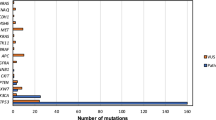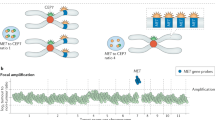Abstract
Aberrant signalling through the hepatocyte growth factor/scatter factor receptor Met has been implicated in various aspects of the development of human cancer including the promotion of tumour invasion, angiogenesis and metastasis. Moreover, experimental data indicate that activation of the Met receptor may be involved in cellular resistance towards antineoplastic treatments such as chemotherapy and ionizing radiation. We determined the prevalence and clinical impact of the Met-activating mutation Y1253D in patients with squamous cell cancer of the oropharynx treated by radical radiotherapy. To screen archival tissue for the presence of a low-abundance point mutation, we developed a sensitive screening method using real-time polymerase chain reaction along with peptide nucleic acid-based DNA clamping and melting curve analysis. By this approach, Met Y1253D was detected in tumours of 15 out of 138 patients (10.9%). Both univariate and multivariate survival analysis revealed Met Y1253D to be significantly associated with impaired local tumour control. Our results provide evidence that the Met-activating mutation Y1253D is present in a notable subset of patients with oropharyngeal cancer and indicate that it may interfere with radioresponsiveness of these tumours, supporting the notion of aberrant Met signalling as a potential target for radiosensitization.
This is a preview of subscription content, access via your institution
Access options
Subscribe to this journal
Receive 50 print issues and online access
$259.00 per year
only $5.18 per issue
Buy this article
- Purchase on Springer Link
- Instant access to full article PDF
Prices may be subject to local taxes which are calculated during checkout



Similar content being viewed by others
References
Aebersold DM, Kollar A, Beer KT, Laissue J, Greiner RH and Djonov V . (2001). Int. J. Cancer, 96, 41–54.
Bowers DC, Fan S, Walter KA, Abounader R, Williams JA, Rosen EM and Laterra J . (2000). Cancer Res., 60, 4277–4283.
Chiara F, Michieli P, Pugliese L and Comoglio PM . (2003). J. Biol. Chem., 12, 12.
Danilkovitch-Miagkova A and Zbar B . (2002). J. Clin. Invest., 109, 863–867.
Dent P, Yacoub A, Contessa J, Caron R, Amorino G, Valerie K, Hagan MP, Grant S and Schmidt-Ullrich R . (2003). Radiat. Res., 159, 283–300.
Di Renzo MF, Olivero M, Martone T, Maffe A, Maggiora P, Stefani AD, Valente G, Giordano S, Cortesina G and Comoglio PM . (2000). Oncogene, 19, 1547–1555.
Fan S, Ma YX, Wang JA, Yuan RQ, Meng Q, Cao Y, Laterra JJ, Goldberg ID and Rosen EM . (2000). Oncogene, 19, 2212–2223.
Fan S, Wang JA, Yuan RQ, Rockwell S, Andres J, Zlatapolskiy A, Goldberg ID and Rosen EM . (1998). Oncogene, 17, 131–141.
Lindel K, Beer KT, Laissue J, Greiner RH and Aebersold DM . (2001). Cancer, 92, 805–813.
Lorenzato A, Olivero M, Patane S, Rosso E, Oliaro A, Comoglio PM and Di Renzo MF . (2002). Cancer Res., 62, 7025–7030.
Maulik G, Shrikhande A, Kijima T, Ma PC, Morrison PT and Salgia R . (2002). Cytokine Growth Factor Rev., 13, 41–59.
Park WS, Dong SM, Kim SY, Na EY, Shin MS, Pi JH, Kim BJ, Bae JH, Hong YK, Lee KS, Lee SH, Yoo NJ, Jang JJ, Pack S, Zhuang Z, Schmidt L, Zbar B and Lee JY . (1999). Cancer Res., 59, 307–310.
Pietras RJ, Poen JC, Gallardo D, Wongvipat PN, Lee HJ and Slamon DJ . (1999). Cancer Res., 59, 1347–1355.
Raben D, Bianco C, Helfrich B, Weng E, Ciardiello F and Harari P . (2002). Expert Rev. Anticancer Ther., 2, 461–471.
Rodrigues GA and Park M . (1994). Curr. Opin. Genet. Dev., 4, 15–24.
Schmidt L, Junker K, Nakaigawa N, Kinjerski T, Weirich G, Miller M, Lubensky I, Neumann HP, Brauch H, Decker J, Vocke C, Brown JA, Jenkins R, Richard S, Bergerheim U, Gerrard B, Dean M, Linehan WM and Zbar B . (1999). Oncogene, 18, 2343–2350.
Sun X, Hung K, Wu L, Sidransky D and Guo B . (2002). Nat. Biotechnol., 20, 186–189.
To CT and Tsao MS . (1998). Oncol. Rep., 5, 1013–1024.
Turner BC, Haffty BG, Narayanan L, Yuan J, Havre PA, Gumbs AA, Kaplan L, Burgaud JL, Carter D, Baserga R and Glazer PM . (1997). Cancer Res., 57, 3079–3083.
Acknowledgements
We thank MF Di Renzo for providing the Met wild type and Met Y1253D containing expression vectors as well as genomic DNA from a Y1253D-carrying tumour and J Laissue for pathological review of the tumour samples. This study was supported by the Bernese Cancer League.
Author information
Authors and Affiliations
Corresponding author
Rights and permissions
About this article
Cite this article
Aebersold, D., Landt, O., Berthou, S. et al. Prevalence and clinical impact of Met Y1253D-activating point mutation in radiotherapy-treated squamous cell cancer of the oropharynx. Oncogene 22, 8519–8523 (2003). https://doi.org/10.1038/sj.onc.1206968
Received:
Revised:
Accepted:
Published:
Issue Date:
DOI: https://doi.org/10.1038/sj.onc.1206968
Keywords
This article is cited by
-
HGF/c-MET pathway in cancer: from molecular characterization to clinical evidence
Oncogene (2021)
-
The multiple paths towards MET receptor addiction in cancer
Oncogene (2018)
-
C-MET as a new therapeutic target for the development of novel anticancer drugs
Clinical and Translational Oncology (2010)
-
MET Y1253D-activating point mutation and development of distant metastasis in advanced head and neck cancers
Clinical & Experimental Metastasis (2009)
-
The Met kinase inhibitor SU11274 exhibits a selective inhibition pattern toward different receptor mutated variants
Oncogene (2004)



